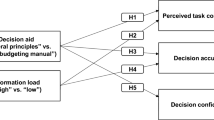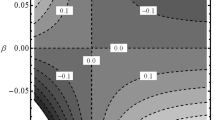Abstract
Balanced IT Decision Card — An Instrument for Investment Controlling of IT Projects p]This paper introduces a Balanced IT Decision Card. It aims at overcoming the shortcomings of common decision making processes on large information technology (IT) projects.
The investment decision should be based on an evaluation process that takes into account monetary and non-monetary measures. Given this infinite amount of data, decision makers need tools that present the important information in a simple and structured way. Therefore, this working paper makes use of the latest findings of cognition theory. Furthermore, the IT project must be integrated in the overall IT strategy, so that synergies with other IT projects can be realized. Following this argumentation, the Balanced Scorecard approach is adopted to control the investment process of IT projects.
Similar content being viewed by others
Literatur
Altrogge, Gunter: Investition. Oldenbourg, München 1996.
Baschin, Anja: Die Balanced Scorecard für Ihren Informations-Technologie Bereich. Campus Fachbuch, Frankfurt 2001.
Baschin, Anja; Steffen, Andreas: IT-Controlling mit der Balanced Scorecard. In: Kosten-rechungspraxis 45 (2001) 6, S. 367–371.
Brayfield, A. H.; Crockett, W. H.: Employee Attitudes and Employee Performance. In: Psychological Bulletin 52 (1955) 5, S. 396–424.
Brynjolfsson, Erik; Hitt, Lorin: Paradox lost? Firm-level Evidence on the Return to Information Systems Spending. In: Management Science 42 (1996) 4, S. 541–558.
Brynjolfsson, Erik; Yang, Shinkyu: Information Technology and Productivity: A review of the literature. In: Advances in Computer 43 (1996) 2, S. 179–214.
Clemens, Erik K.: Evaluation of strategic Investments in Information Technology. In: Communications of the ACM 34 (1991) 1, S. 22–36.
Dobbins, Richard; Witt, Stephan F.: Practical Financial Management. Basil Blackwell, New York 1988.
Gleich, Ronald: Balanced Scorecard. In: Die Betriebswirtschaft 57 (1997) 3, S. 432–435.
Graeser, Valerie; Willcocks, Leslie; Pisanias, Nikolaos: Developing the IT Scorecard. Business Intelligence Ltd., London 1998.
Heskett, James L.; Jones, Thomas O.; Loveman, Gary, W.; Sasser, W. Earl; Schlesinger, Leonard T.: Putting the Service-Profit Chain to Work. In: Harvard Business Review 72 (1994) March-April, S. 164–174.
Hommel, Ulrich; Lehmann, Hanna: Anwendung des Realoptionsansatzes in der Bewertungspraxis. In: Hommel, Ulrich; Scholich, Martin; Vollrath, Rorbert (Hrsg.): Realoptionen in der Unternehmenspraxis — Wert schaffen durch Flexibilität. Springer, Berlin 2001, S. 113–129.
Hoitsch, Hans-Jörg; Lingnau, Volker: Kosten- und Erlö srechnung — Eine controllingorientierte Einfü hrung. Springer, Berlin 2002.
Hommel, Ulrich; Müller, Jürgen: Real-optionsbasierte Investitionsbewertung. In: Finanzbetrieb 1 (1999) 8, S. 177–188.
Hommel, Ulrich; Pritsch, Gunnar: Marktorientierte Investitionsbewertung mit dem Realoptionsansatz: Ein Implementierungsleitfaden für die Praxis. In: Schweizerische Gesellschaft für Finanzmarktforschung 13 (1999) 2, S. 121–144.
Hillenbrand, Markus; Verney, Aline; Müller, Paul; Koenig, Tom: Web Services for Sensor Node Access. In: http://www.newcastle.research.ec.org/cabernet/workshops/plenary/5th-plenary-papers/Paper_Kaiserslautern.pdf, Abruf am 2004-01-08.
Kaplan, Robert S.; Norton, David P.: The Balanced Scorecard — Measures that drive performance. In: Harvard Business Review 70 (1992) January-February, S. 71–79.
Kaplan, Robert S.; Norton, David P.: Die Strategiefokussierte Organisation — Führen mit der Balanced Scorecard. Schäffer-Poeschel, Stuttgart 2001.
Kü tz, Martin: Balanced Scorecard im IT-Controlling. In: Blomer, Roland; Bernhard, Martin G. (Hrsg.): Report Balanced Scorecard in der IT. Symposion Publishing, Düsseldorf 2002, S. 49–95.
Lingnau, Volker: Vom homo oeconomicus zum homo organisans — Zur Bedeutung von Herbert A. Simon für die Betriebswirtschaftslehre. In: Zeitschrift für Planung 12 (2001) 4, S. 421–438.
Lipke, Oliver: Activity-Based-Cost Management in der Assekuranz. Konzeption und Implementierungsmöglichkeiten. Dissertation, St. Gallen 1997.
Mateyaschuk, Jennifer: Training Address Project-Management Needs. In: Information-week Online. http://www.informationweek.com/758/project.htm, Oktober 1999, Abruf am 2003-10-29.
Meyer, Mathias; Weingärtner, Stefan: Enterprise Application Integration — Grundlagen. In: Meyer, Matthias (Hrsg.): CRM-Systeme mit EAI — Konzeption, Implementierung und Evaluation. Vieweg, Braunschweig, Wiesbaden 2002, 199–229.
Pritsch, Gunnar; Weber, Jürgen: Die Bedeutung des Realoptionsansatzes aus Controlling-Sicht. In: Hommel, Ulrich; Scholich, Martin; Vollrath, Rorbert (Hrsg.): Realoptionen in der Unternehmenspraxis. Springer, Berlin 2001, S. 13–43.
PWC Deutsche Revision: Die Balanced Scorecard im Praxistest: Wie zufrieden sind die Anwender? Frankfurt am Main 2001.
Raisinghani, Mareh, S.: A Balanced Analytic Approach to Strategic Electronic Commerce Decisions: A Framework of the Evaluation Method. In: Van Grembergen, Wim: Information Technology Evaluation Methods and Management. Idea Group Publishing, Hershey 2001
Reichmann, Thomas: Controlling mit Kennzahlen und Managementberichten. 6. Auflage, Vahlen, München 2001.
Schärer, Markus; Botteron, Pascal: Wie lässt sich der Wert strategischer Projekte bestimmen? In: Der Schweizer Treuhänder 75 (2001) 11, S. 1119–1126.
Seeger, Heinrich: Existenzfrage: Wie schwer wiegt IT? In: Witte, Christoph (Hrsg.): CIO — IT-Strategie für Manager 12 (2003) 3. Echter Druck, Wü rzburg 2003.
Simon, Herbert. A.: Entscheidungsverhalten in Organisationen: eine Untersuchung von Entscheidungsprozessen in Management und Verwaltung. Moderne Industrie, Landsberg am Lech 1981.
Solow, Robert M.: We’d better watch out. In: New York Times, July 12, Book Review, 1987, S. 36.
Stock, Ruth: Der Zusammenhang zwischen Mitarbeiter- und Kundenzufriedenheit — Direkte, indirekte und moderierende Effekte. Deutscher Universitäts-Verlag, 2. Auflage, Wiesbaden 2003.
Tewald, Claudia: Die Balanced Scorecard für die IV. In: von Dobschütz, Leonhard; Barth, Manfred; Jäger-Goy, Heidi; Kütz, Martin; Möl-ler, Hans-Peter: IV-Controlling Konzepte — Umsetzungen — Erfahrungen. Gabler, Wiesbaden 2000
Tewald, Claudia: Performance Measurement in der IV mithilfe der Balanced Scorecard. In: IM Die Fachzeitschrift für Information Management & Consulting, 16 (2001) 4, S. 92–97.
Thiel, Wolfgang; Kronen, Juliane; Grebe, Michael: The Boston Consulting Group — Tightening the Reins on ITspending. http://www.bcg.com/publications/files/Tightening_Reins_IT_OfA_Nov01.pdf, November 2001, Abruf am 2003-10-29.
Wall, F.: Ursache-Wirkungsbeziehungen als ein zentraler Bestandteil der Balanced Score-card — Mö glichkeiten und Grenzen Ihrer Gewinnung. In: Controlling, 13 (2001) 2, S. 65–74.
Author information
Authors and Affiliations
Corresponding author
Rights and permissions
About this article
Cite this article
Jonen, A., Lingnau, V., Müller, J. et al. Balanced IT-Decision-Card Ein Instrument für das Investitionscontrolling von IT-Projekten. Wirtschaftsinf 46, 196–203 (2004). https://doi.org/10.1007/BF03250937
Issue Date:
DOI: https://doi.org/10.1007/BF03250937




